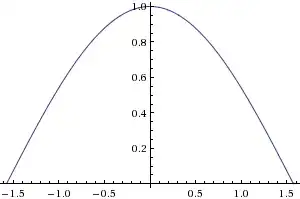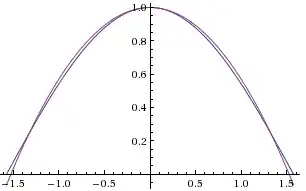In the interval $[-\frac{\pi}{2},\frac{\pi}{2}]$, the cosine function superficially resembles an inverted parabola of the form $-ax^2+1$:

I wanted to know more and computed the $L^2$ norm (surrounding square root omitted for readability):
$$ \int_{-\pi/2}^{\pi/2} \,(\cos(x)-(ax^2+1))^2\,dx \quad=\quad \frac{\pi^5 a^2}{80}+\frac{1}{6}(48-6\pi^2+\pi^3) a+\frac{3\pi}{2}-4 $$
Minimizing the expression on the right hand side with respect to $a$ yields the enigmatic solution
$$a=\frac{-20\pi^3+120\pi^2-960}{3\pi^5}=-0.431...$$
which indeed shows a nice agreement:

Thus, the parabola $ax^2+1$ with this value for $a$ is in some sense the best parabolic approximation to the cosine in the largest interval in which the cosine is concave like the parabola is.
By now you have probably guessed my question: What is going on? I don't know what I expected the optimum value of $a$ to look like, but this is definitely not it. Where do these "magic" numbers $20$, $120$, $960$ and $3$ come from? Is there any way to understand this result other than computing the integral?